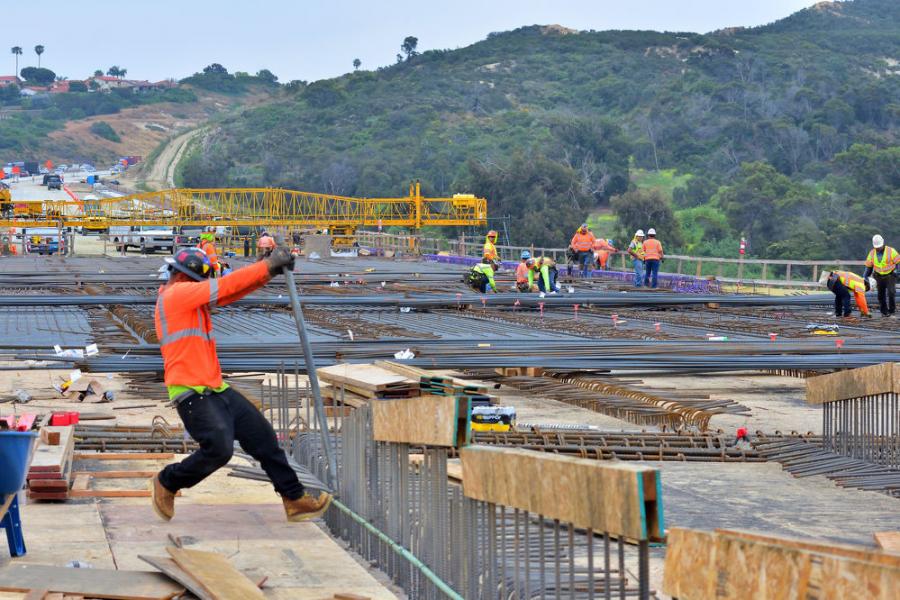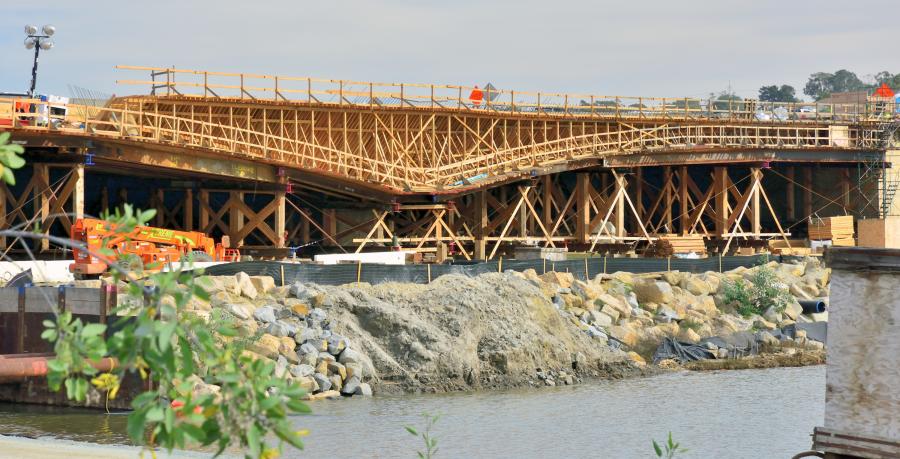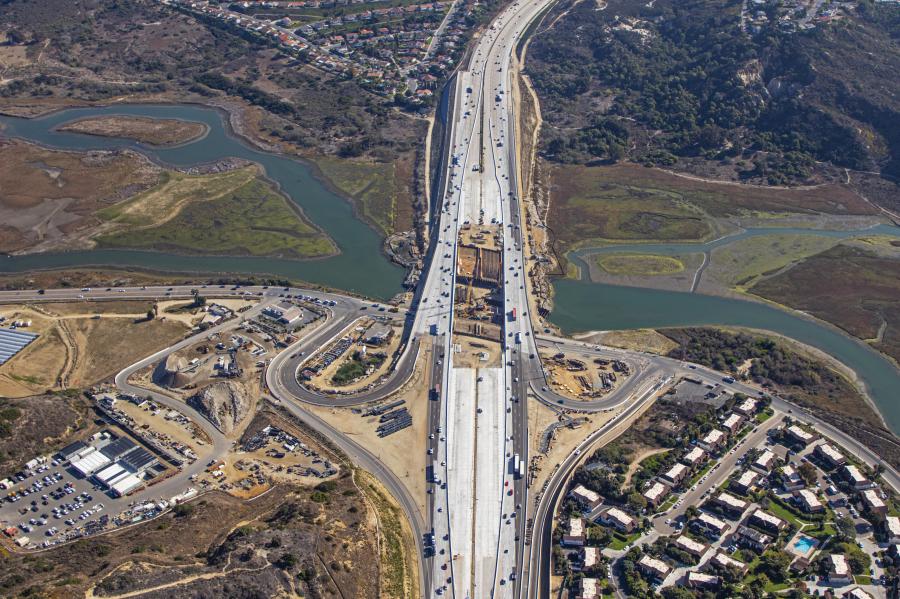In February 2020, Build NCC construction crews reached the halfway point of the project and successfully shifted traffic to the I-5 San Elijo Lagoon highway bridge in Encinitas.
Foundation, column and bridge superstructure construction is under way at the Interstate 5 (I-5) San Elijo Lagoon highway bridge located above Manchester Avenue and a lagoon channel separating the central and east basins of the 960-acre San Elijo Lagoon coastal wetland in Encinitas, Calif., a city along the northern San Diego County coastline.
The bridge is being built by the joint venture of Flatiron, Skanska, and Stacy and Witbeck (FSSW), which is responsible for the Build North Coast Corridor (NCC) construction, as well as other nearby multimodal and active transportation projects.
The project is part of the first phase of construction of the Caltrans and the San Diego Association of Governments (SANDAG) North Coast Corridor Program. The $6 billion, 40-year vision is an implementation blueprint for developing and building projects as part of a holistic and connected system of mobility facilities.
Construction Progress
The JV has been making steady and solid progress on construction.
In February 2020, Build NCC construction crews reached the halfway point of the project and successfully shifted traffic to the I-5 San Elijo Lagoon highway bridge in Encinitas. Motorists were diverted onto two new highway bridges, creating a slight curve in both northbound and southbound directions, providing space for crews to rebuild the inside portion of the highway bridge above Manchester Avenue and the San Elijo Lagoon.
One month later, in March 2020, crews demolished and dismantled the original, 57-year-old northbound and southbound I-5 highway bridge structures. An estimated 4,000 cu. yds. of concrete from the old bridges was recycled into roadway base material and reused within the Build NCC project.
A total of 750,000 lbs. of original steel from the bridge – or the weight of 62 elephants – was also separated and recycled. Through spring, summer and fall, crews focused their efforts on forming the underground foundation for the new interior portion of the bridge, performing the final concrete pour in December 2020.
The new bridge has 22 support columns running 145-ft. deep and eight support columns running 255-ft. deep below ground level, which will allow the bridge to support current and future travel demands and to withstand seismic events. Sediment unearthed from the ongoing foundation column work was transported from the bridge construction site and used to support ongoing San Elijo Lagoon restoration andplant establishment efforts.
The bridge reconstruction will help relieve traffic congestion, improve lagoon tidal flows and create new bike and pedestrian paths when complete in late 2021.
Project Challenges
The JV is dealing with several construction challenges, which were identified and addressed during the design phase.
"One project challenge we overcame was how best to ensure structural stability and integrity when pouring and forming below-ground bridge piles within the lagoon's marine environment," said Adrian Cortez, Caltrans senior bridge engineer. "Through our construction manager general contractor project model, we were able to develop a solution together with our joint-venture contractor."
To construct the bridge foundation, crews installed welded steel casings and excavated sediment to form cast-in-drilled-hole (CIDH) underground concrete bridge piles, or columns. Build NCC crews used a hydraulic oscillator to rotate the steel casings in a circular motion back and forth into the ground as opposed to a standard heavy-duty pile driving operation.
"This innovative construction approach was adapted specifically to meet the challenges presented by the lagoon's marine environment and helped mitigate construction-related impacts on surrounding residential communities," said Cortez.
The major subcontractors for the project include Condon Johnson for bridge pile foundations; Vanguard for concrete barrier rail construction; Pacific Restoration Group for landscaping; and Select Electric for electrical utility work.
New materials to be used should include: 133,902 tons of concrete, 34,450 tons of asphalt and 4,465 tons of steel.
Equipment in use includes a Kobelco crane; a JLG forklift; a JLG 1255 material handler; a Genie 65-70 ft. manlift; a Leffer PP1000; a Leffer hydraulic oscillator; a Genie S-65 hydraulic lift; a Bauer BG46 premium line frill rig; a Liebherr HS-895; a rubber tire loader; a mini excavator; and a concrete pump.
The JV purchases and rents equipment from Ken Grody Ford in Carlsbad; Otay Mesa Sales Inc. in San Diego; United Rentals in San Diego; and Savala Equipment Rentals in Irvine.
Project Background
The project's efforts align with SANDAG's vision for the 2021 Regional Plan, which reimagines how people and goods could move throughout the region in the 21st century, fundamentally shaped by five key strategies for mobility, collectively known as the 5 Big Moves — Complete Corridors (multimodal roads), Transit Leap (fast and flexible transit), Mobility Hubs (connection points), Flexible Fleets (first and last mile options) and the Next OS (enabling technology).
The Complete Corridor model provides an integrated system of multimodal transportation options that will help improve the quality of life for residents, create a stronger local and regional economy for the future, and enhance the coastal environment along the I-5 corridor.
The Build NCC program began in 2017 and is anticipated to be complete in 2022. The $869 million project is funded through a combination of federal, state, and local sources, including the TransNet program, a voter-approved half-cent countywide sales tax administered by SANDAG that helps fund regional transportation projects. The highway portion of Build NCC is estimated to cost $663 million.
San Elijo Lagoon highway bridge construction broke ground in spring 2017 and is anticipated to be completed in late 2021. Once complete, the reconstructed bridge will improve San Elijo Lagoon tidal flows and feature one new carpool/HOV Lane in each direction on I-5 and a new suspended bicycle and pedestrian bridge below, connecting Manchester Avenue to the lagoon trail network. The bridge, first constructed and opened to motorists in 1963, is being lengthened and widened to its ultimate configuration, which will eventually accommodate two carpool/HOV lanes in each direction as part the second phase of the NCC program in 2035. CEG
Irwin Rapoport
A journalist who started his career at a weekly community newspaper, Irwin Rapoport has written about construction and architecture for more than 15 years, as well as a variety of other subjects, such as recycling, environmental issues, business supply chains, property development, pulp and paper, agriculture, solar power and energy, and education. Getting the story right and illustrating the hard work and professionalism that goes into completing road, bridge, and building projects is important to him. A key element of his construction articles is to provide readers with an opportunity to see how general contractors and departments of transportation complete their projects and address challenges so that lessons learned can be shared with a wider audience.
Rapoport has a BA in History and a Minor in Political Science from Concordia University. His hobbies include hiking, birding, cycling, reading, going to concerts and plays, hanging out with friends and family, and architecture. He is keen to one day write an MA thesis on military and economic planning by the Great Powers prior to the start of the First World War.
Read more from Irwin Rapoport here.
Today's top stories





















